Deck 19: Imperial America: the United States in the World, 1890-1914
Question
Question
Question
Question
Question
Question
Question
Question
Question
Question
Question
Question
Question
Question
Question
Question
Question
Question
Question
Question
Question
Question
Question
Question
Question
Question
Question
Question
Question
Question
Question
Question
Question
Question
Question
Question
Question
Question
Question
Question
Question
Question
Question
Question
Question
Question
Question
Question
Question

Unlock Deck
Sign up to unlock the cards in this deck!
Unlock Deck
Unlock Deck
1/49
Play
Full screen (f)
Deck 19: Imperial America: the United States in the World, 1890-1914
1
Although the Spanish-American War was described as a "splendid little war," what factor made this depiction untrue?
A) American troops dealt with heavy military casualties due to superior Spanish military forces.
B) The American navy experienced a heavy defeat in the Philippines.
C) Americans suffered more deaths due to diseases like yellow fever rather than through battle.
D) The United States failed to gain any territory at the end of this war.
A) American troops dealt with heavy military casualties due to superior Spanish military forces.
B) The American navy experienced a heavy defeat in the Philippines.
C) Americans suffered more deaths due to diseases like yellow fever rather than through battle.
D) The United States failed to gain any territory at the end of this war.
Americans suffered more deaths due to diseases like yellow fever rather than through battle.
2
Why did the illustrator create this image that showed the destruction of the battleship Maine in Havana Harbor on February 15, 1898?
A) to accurately report the destruction that took place in the harbor
B) to present a sensationalized version of the explosion so that war could be declared on Spain
C) to show the faulty naval procedures that led to a spontaneous combustion on board
D) to place blame on Cuban revolutionaries who wanted independence from Spain
A) to accurately report the destruction that took place in the harbor
B) to present a sensationalized version of the explosion so that war could be declared on Spain
C) to show the faulty naval procedures that led to a spontaneous combustion on board
D) to place blame on Cuban revolutionaries who wanted independence from Spain
to present a sensationalized version of the explosion so that war could be declared on Spain
3
Commodore George Dewey led the Americans to victory .
A) at San Juan Heights
B) in Manila Harbor
C) in the Hawaiian Islands
D) in Santiago
A) at San Juan Heights
B) in Manila Harbor
C) in the Hawaiian Islands
D) in Santiago
in Manila Harbor
4
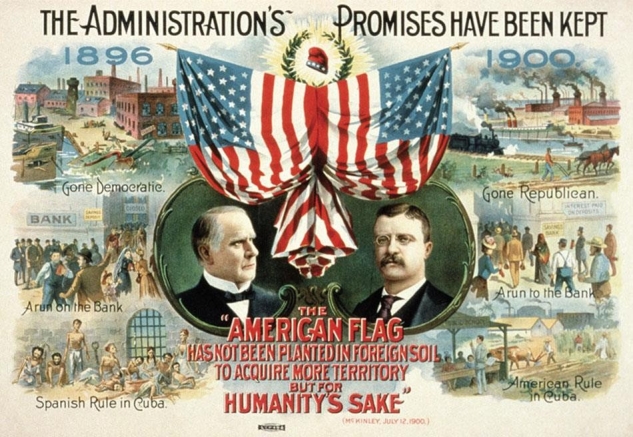
How did this Republican campaign poster from the election of 1900 address the idea that the United States should establish an American overseas empire?
A) American intervention made life in Cuba more difficult.
B) American intervention was done for the purpose of acquiring overseas markets.
C) American intervention in foreign nations improved their quality of life.
D) American intervention showcased its military and naval superiority.

Unlock Deck
Unlock for access to all 49 flashcards in this deck.
Unlock Deck
k this deck
5
After most of Spain's colonies in the Western Hemisphere won independence during the early nineteenth century, which two remaining colonies in this region stayed loyal to Spain?
A) Colombia and Panama
B) Cuba and Puerto Rico
C) Argentina and Chile
D) Mexico and Venezuela
A) Colombia and Panama
B) Cuba and Puerto Rico
C) Argentina and Chile
D) Mexico and Venezuela

Unlock Deck
Unlock for access to all 49 flashcards in this deck.
Unlock Deck
k this deck
6
What compelled the United States to intervene in the Cuban revolt against Spain?
A) apprehension about the revolutionary ideology of the Cubans
B) the intent to protect both Cuban and American economic interests in Cuba
C) the wish to halt British expansionism and secure markets in the Caribbean
D) the Republicans' hope to open new markets in the Caribbean
A) apprehension about the revolutionary ideology of the Cubans
B) the intent to protect both Cuban and American economic interests in Cuba
C) the wish to halt British expansionism and secure markets in the Caribbean
D) the Republicans' hope to open new markets in the Caribbean

Unlock Deck
Unlock for access to all 49 flashcards in this deck.
Unlock Deck
k this deck
7
How was American imperialism of the late 1800s different from its earlier form of Manifest Destiny?
A) Imperialists treated nonwhites more humanely than Indians had been treated under Manifest Destiny.
B) Manifest Destiny encouraged expansion through technological innovations while imperialism did not.
C) American imperialists had little to no interest in spreading their democratic values abroad.
D) Imperialism focused on overseas colonization in order to create a U.S. global economy.
A) Imperialists treated nonwhites more humanely than Indians had been treated under Manifest Destiny.
B) Manifest Destiny encouraged expansion through technological innovations while imperialism did not.
C) American imperialists had little to no interest in spreading their democratic values abroad.
D) Imperialism focused on overseas colonization in order to create a U.S. global economy.

Unlock Deck
Unlock for access to all 49 flashcards in this deck.
Unlock Deck
k this deck
8
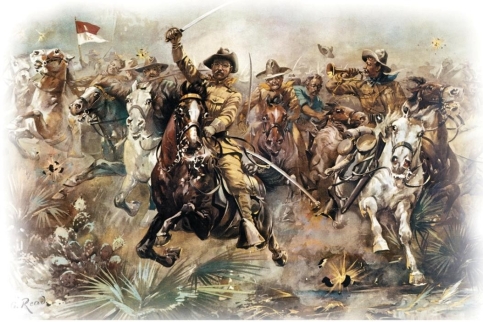
When reviewing illustrations and pictures of the charge on the San Juan hills like the one above, eyewitness journalist Richard Harding Davis recalled that "none of them seem to show it just as I remember it." Why did Davis make such a statement?
A) Theodore Roosevelt did not actually participate in the advance.
B) The actual advance was slow and on foot.
C) The Rough Riders were actually predominantly African American.
D) The advance was actually a failure.

Unlock Deck
Unlock for access to all 49 flashcards in this deck.
Unlock Deck
k this deck
9
Leading up to the Spanish-American War in 1898, the yellow press controlled by Joseph Pulitzer and William Randolph Hearst _.
A) endorsed a policy of isolationism
B) focused more attention on local scandals than foreign affairs
C) used sensationalism to stir up war fever over Cuba
D) published editorials criticizing American imperialism
A) endorsed a policy of isolationism
B) focused more attention on local scandals than foreign affairs
C) used sensationalism to stir up war fever over Cuba
D) published editorials criticizing American imperialism

Unlock Deck
Unlock for access to all 49 flashcards in this deck.
Unlock Deck
k this deck
10
Today, many experts believe the Maine probably sank due to _.
A) the negligence of Commodore George Dewey
B) excessive weight from the munitions cargo
C) explosives planted by Spanish saboteurs
D) an internal explosion
A) the negligence of Commodore George Dewey
B) excessive weight from the munitions cargo
C) explosives planted by Spanish saboteurs
D) an internal explosion

Unlock Deck
Unlock for access to all 49 flashcards in this deck.
Unlock Deck
k this deck
11
How did late nineteenth-century imperialism differ from earlier forms of European and American colonialism?
A) Imperialism placed greater emphasis on "civilizing" nonwhites and non-white Christians.
B) Imperialism relied little on settlers moving to these new colonial holdings.
C) Imperialists had little interest in exploiting the natural resources of their new holdings.
D) People colonized by imperialism were happier than under earlier forms of colonialism.
A) Imperialism placed greater emphasis on "civilizing" nonwhites and non-white Christians.
B) Imperialism relied little on settlers moving to these new colonial holdings.
C) Imperialists had little interest in exploiting the natural resources of their new holdings.
D) People colonized by imperialism were happier than under earlier forms of colonialism.

Unlock Deck
Unlock for access to all 49 flashcards in this deck.
Unlock Deck
k this deck
12
How did the Platt Amendment specifically impact Cuba after the Spanish-American War?
A) The United States withdrew troops from Cuba without making additional demands.
B) Cuba became a fully-independent nation with all rights and privileges associated with independence.
C) The United States agreed to leave Cuba alone and not meddle in its foreign policies.
D) Cuba became a protectorate of the United States.
A) The United States withdrew troops from Cuba without making additional demands.
B) Cuba became a fully-independent nation with all rights and privileges associated with independence.
C) The United States agreed to leave Cuba alone and not meddle in its foreign policies.
D) Cuba became a protectorate of the United States.

Unlock Deck
Unlock for access to all 49 flashcards in this deck.
Unlock Deck
k this deck
13
How did the Teller Amendment of 1898 affect Cuba differently from other Spanish possessions in the Caribbean and Pacific?
A) It promised to leave control of the island to its people.
B) It declared Cuba an American protectorate.
C) It set up most favored nation trading rights with Cuba.
D) It assured Cuba that the United States would provide financial assistance to the island.
A) It promised to leave control of the island to its people.
B) It declared Cuba an American protectorate.
C) It set up most favored nation trading rights with Cuba.
D) It assured Cuba that the United States would provide financial assistance to the island.

Unlock Deck
Unlock for access to all 49 flashcards in this deck.
Unlock Deck
k this deck
14
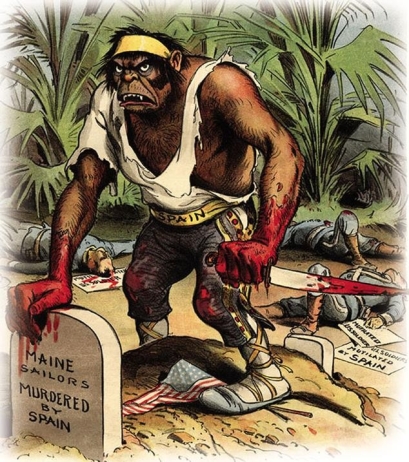
How did The Spanish Brute, which appeared on an 1898 magazine cover of Judge magazine, promote racist notions of white supremacy among Americans during the Spanish-American War?
A) The figure is shown as a dark-skinned ape-like Spaniard who posed a threat to civilization.
B) The figure is trampling on the American flag.
C) The figure is shown as a monster who mutilated American soldiers after the charge on the San Juan Hills.
D) The figure is depicted as a bloodthirsty beast responsible for explosion of the Maine.

Unlock Deck
Unlock for access to all 49 flashcards in this deck.
Unlock Deck
k this deck
15
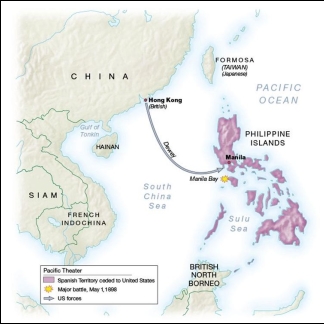
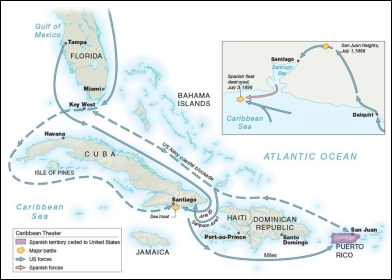
Based on these maps of the Pacific and Caribbean theaters of war, what accounted for a quick and overwhelming American victory in the Spanish-American War?
A) guerrilla attacks and ambushes launched against Spanish forces
B) powerful American professional military forces
C) tight alliances with both the Cuban and Filipino rebels
D) superior American naval power

Unlock Deck
Unlock for access to all 49 flashcards in this deck.
Unlock Deck
k this deck
16
What was the primary reason why the United States desired annexation of Hawaii?
A) U.S. ships heading to the Philippines needed access to a naval base for refueling.
B) Queen Liliuokalani wanted to reduce American influence in Hawaii.
C) Hawaiians were in need of missionary services in order to convert to Christianity.
D) The Hawaiian Patriotic League wanted closer ties to the United States.
A) U.S. ships heading to the Philippines needed access to a naval base for refueling.
B) Queen Liliuokalani wanted to reduce American influence in Hawaii.
C) Hawaiians were in need of missionary services in order to convert to Christianity.
D) The Hawaiian Patriotic League wanted closer ties to the United States.

Unlock Deck
Unlock for access to all 49 flashcards in this deck.
Unlock Deck
k this deck
17
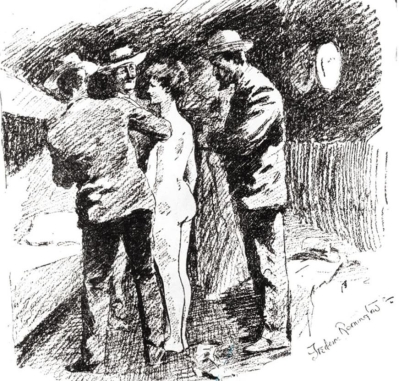
How did Frederic Remington's illustration that was published in the New York Journal
Generate American sympathy for the Cuban rebellion against Spain?
A) The Cuban woman appears to be a victim of starvation as a result of Spain's reconcentration policies.
B) The Cubans are shown as concerned doctors who are treating patients for malaria and yellow fever.
C) Spain is portrayed as a wanton temptress to her colonists in Cuba.
D) Cuba appears as a virtuous and victimized white woman who stands defiantly to her Spanish searchers.

Unlock Deck
Unlock for access to all 49 flashcards in this deck.
Unlock Deck
k this deck
18
What was reconcentration?
A) the investments of Americans in Cuban agriculture and industry
B) the practice of providing both real and fabricated stories of atrocities in Cuba to the yellow press
C) the policy of removing Cuban peasants to camps and destroying their crops
D) the guerilla tactics employed by Cuban rebels to deprive Spain of revenue
A) the investments of Americans in Cuban agriculture and industry
B) the practice of providing both real and fabricated stories of atrocities in Cuba to the yellow press
C) the policy of removing Cuban peasants to camps and destroying their crops
D) the guerilla tactics employed by Cuban rebels to deprive Spain of revenue

Unlock Deck
Unlock for access to all 49 flashcards in this deck.
Unlock Deck
k this deck
19
The 1890 book, The Influence of Sea Power Upon History, influenced the United States to invest in .
A) transatlantic telegraph cables
B) merchant steamships
C) its naval power
D) industrial hydropower
A) transatlantic telegraph cables
B) merchant steamships
C) its naval power
D) industrial hydropower

Unlock Deck
Unlock for access to all 49 flashcards in this deck.
Unlock Deck
k this deck
20
Which ideology did Congregational minister Josiah Strong allude to in his book Our Country: Its Possible Future and Its Present Crisis when he stated that "it seems to me that God, with infinite wisdom and skill, is training the Anglo-Saxon race to prevail" in the competition to control lands throughout the world?
A) social Darwinism
B) Manifest Destiny
C) imperialism
D) reconcentration
A) social Darwinism
B) Manifest Destiny
C) imperialism
D) reconcentration

Unlock Deck
Unlock for access to all 49 flashcards in this deck.
Unlock Deck
k this deck
21
In the 1922 case of Takno Ozawa v. United States, the U.S. Supreme Court decided that
A) all immigration from Asia was banned starting in 1924
B) Japanese immigrants were ineligible for citizenship because they were not white
C) Asians who were classified as Caucasians were not legally white and could not become citizens
D) all Asians had to be segregated in one set of schools in San Francisco
A) all immigration from Asia was banned starting in 1924
B) Japanese immigrants were ineligible for citizenship because they were not white
C) Asians who were classified as Caucasians were not legally white and could not become citizens
D) all Asians had to be segregated in one set of schools in San Francisco

Unlock Deck
Unlock for access to all 49 flashcards in this deck.
Unlock Deck
k this deck
22
"Picture brides" were .
A) young immigrants who came to California to become movie stars
B) women who placed ads in newspapers in search of husbands
C) Japanese women in long-distance, arranged marriages to men in the United States
D) women whose marriage certificates were lost during the 1906 earthquake
A) young immigrants who came to California to become movie stars
B) women who placed ads in newspapers in search of husbands
C) Japanese women in long-distance, arranged marriages to men in the United States
D) women whose marriage certificates were lost during the 1906 earthquake

Unlock Deck
Unlock for access to all 49 flashcards in this deck.
Unlock Deck
k this deck
23
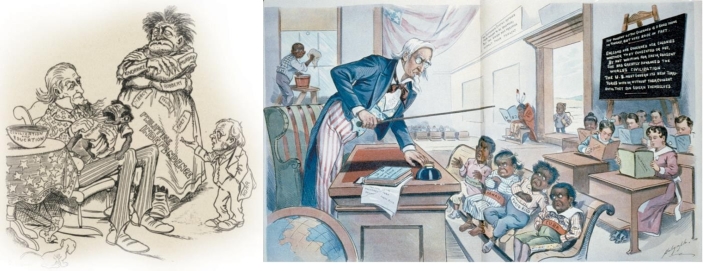
How does the image of Uncle Sam differ in the cartoons Give the Child Over to the Nurse
(left) and School Begins (right)?
A) In Give the Child Over to the Nurse, he is portrayed as looking to the future; in School Begins, he is portrayed as occupied with the past.
B) In Give the Child Over to the Nurse, he is portrayed as offering mere sustenance; in School Begins, he is portrayed as offering a useful education.
C) In Give the Child Over to the Nurse, he is portrayed as truly desiring to help; in School Begins, he is portrayed as indifferent.
D) In Give the Child Over to the Nurse, he is portrayed as nurturing; in School Begins, he is portrayed as both threatening and neglectful.

Unlock Deck
Unlock for access to all 49 flashcards in this deck.
Unlock Deck
k this deck
24
How did the Philippine-American War differ from the earlier Spanish-American War?
A) Americans met less resistance from Filipino insurgents than from the Spanish in Cuba.
B) American forces also had to fight European imperial powers allied with the Filipinos.
C) There were heavier American casualties in a war that took longer to fight.
D) The war was shorter and less fierce than the conflict in Cuba.
A) Americans met less resistance from Filipino insurgents than from the Spanish in Cuba.
B) American forces also had to fight European imperial powers allied with the Filipinos.
C) There were heavier American casualties in a war that took longer to fight.
D) The war was shorter and less fierce than the conflict in Cuba.

Unlock Deck
Unlock for access to all 49 flashcards in this deck.
Unlock Deck
k this deck
25
How did the Insular Cases heard by the U.S. Supreme Court between 1900 and 1904 impact the rights of people living in the Philippines, Hawaii, and Puerto Rico?
A) They were denied any of the natural rights listed in the Bill of Rights.
B) They received the right to vote but were not able to exercise freedom of religion.
C) They kept their rights to free speech and religion but were denied other constitutional protections.
D) They automatically became U.S. citizens and received all rights entitled to citizens.
A) They were denied any of the natural rights listed in the Bill of Rights.
B) They received the right to vote but were not able to exercise freedom of religion.
C) They kept their rights to free speech and religion but were denied other constitutional protections.
D) They automatically became U.S. citizens and received all rights entitled to citizens.

Unlock Deck
Unlock for access to all 49 flashcards in this deck.
Unlock Deck
k this deck
26
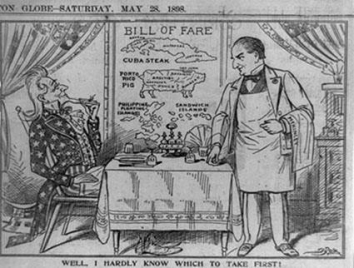
This cartoon portrays American imperialism as being primarily compelled by .
A) curiosity
B) greed
C) evangelism
D) aggression

Unlock Deck
Unlock for access to all 49 flashcards in this deck.
Unlock Deck
k this deck
27
Emilio Aguinaldo was the .
A) Colombian leader who refused to grant rights to the Panama Canal to the United States
B) leader of the Cuban guerillas in the war against Spain
C) Spanish general who tried to put down the rebellion in Cuba
D) Filipino leader who declared independence from Spain and later fought the United States
A) Colombian leader who refused to grant rights to the Panama Canal to the United States
B) leader of the Cuban guerillas in the war against Spain
C) Spanish general who tried to put down the rebellion in Cuba
D) Filipino leader who declared independence from Spain and later fought the United States

Unlock Deck
Unlock for access to all 49 flashcards in this deck.
Unlock Deck
k this deck
28
"Paper sons" were .
A) Chinese boys whose families paid a fee to Chinese men already in the United States to fraudulently claim to be their fathers.
B) Chinese boys who immigrated to Hawaii to work on the sugar plantations.
C) Chinese men who successfully claimed they were American-born after birth records were destroyed in the 1906 San Francisco earthquake.
D) Chinese men who were detained at Angel Island and returned to China.
A) Chinese boys whose families paid a fee to Chinese men already in the United States to fraudulently claim to be their fathers.
B) Chinese boys who immigrated to Hawaii to work on the sugar plantations.
C) Chinese men who successfully claimed they were American-born after birth records were destroyed in the 1906 San Francisco earthquake.
D) Chinese men who were detained at Angel Island and returned to China.

Unlock Deck
Unlock for access to all 49 flashcards in this deck.
Unlock Deck
k this deck
29
What was the Boxer Rebellion in China?
A) the effort of the United States to take control of trade with China
B) a campaign by Chinese militants to drive foreign interests out of China
C) an attempt by China to expel American missionaries
D) a failed attempt by Russia to colonize China
A) the effort of the United States to take control of trade with China
B) a campaign by Chinese militants to drive foreign interests out of China
C) an attempt by China to expel American missionaries
D) a failed attempt by Russia to colonize China

Unlock Deck
Unlock for access to all 49 flashcards in this deck.
Unlock Deck
k this deck
30
Why did Republican Senator Carl Schurz of Missouri believe that colonial acquisitions in tropical zones were unsuitable for American expansion?
A) Democratic institutions did not thrive in these areas.
B) People in these areas were not Christian.
C) Few people lived in these areas.
D) These areas were prone to attack by European powers.
A) Democratic institutions did not thrive in these areas.
B) People in these areas were not Christian.
C) Few people lived in these areas.
D) These areas were prone to attack by European powers.

Unlock Deck
Unlock for access to all 49 flashcards in this deck.
Unlock Deck
k this deck
31
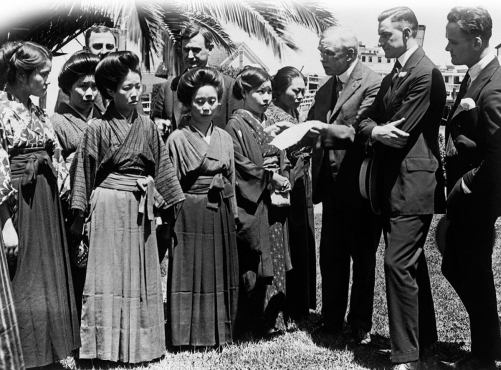
Why did a congressional delegation choose to go to Angel Island in 1920 and confront these Japanese picture brides?
A) to welcome them as future American citizens
B) to rally public support for cutting off the flow of Japanese women coming to the United States
C) to teach them about Christian and democratic values needed in the United States
D) to offer them financial support as they and their husbands purchased agricultural lands

Unlock Deck
Unlock for access to all 49 flashcards in this deck.
Unlock Deck
k this deck
32
What was the Open Door Policy?
A) an international agreement to keep China open to trade with all nations
B) a policy intended to welcome all immigrants to the United States
C) an invitation to all Caribbean nations to request the status of U.S. protectorate
D) the requirement of the United States that all colonized nations welcome American missionaries
A) an international agreement to keep China open to trade with all nations
B) a policy intended to welcome all immigrants to the United States
C) an invitation to all Caribbean nations to request the status of U.S. protectorate
D) the requirement of the United States that all colonized nations welcome American missionaries

Unlock Deck
Unlock for access to all 49 flashcards in this deck.
Unlock Deck
k this deck
33
According to the British poet Rudyard Kipling, the "white man's burden" was the responsibility to .
A) manage global affairs
B) civilize so-called racially inferior peoples
C) develop new technologies
D) maintain economic dominance
A) manage global affairs
B) civilize so-called racially inferior peoples
C) develop new technologies
D) maintain economic dominance

Unlock Deck
Unlock for access to all 49 flashcards in this deck.
Unlock Deck
k this deck
34
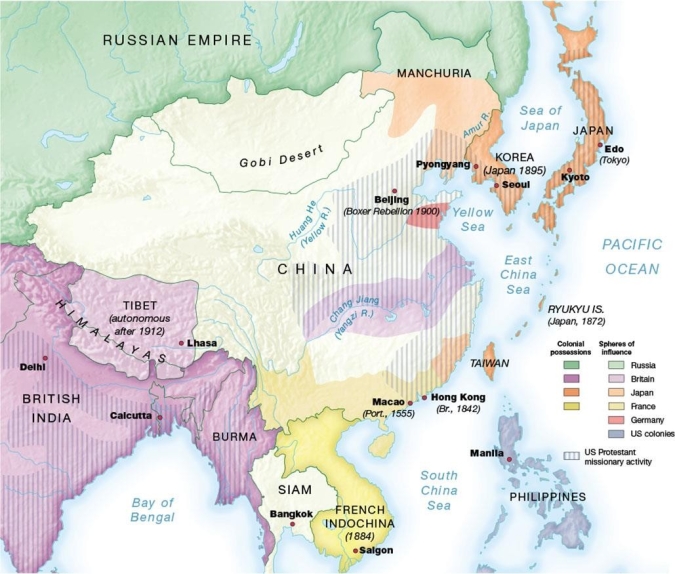
Based on this map of foreign activity in China in 1901, how did the United States try to protect American businessmen and missionaries who had established a presence there?
A) by expanding American interests west of the Huang He River
B) by siding with Russia during the Russo-Japanese War
C) by launching an naval invasion from the Philippines
D) by negotiating with nations that had spheres of influence there

Unlock Deck
Unlock for access to all 49 flashcards in this deck.
Unlock Deck
k this deck
35
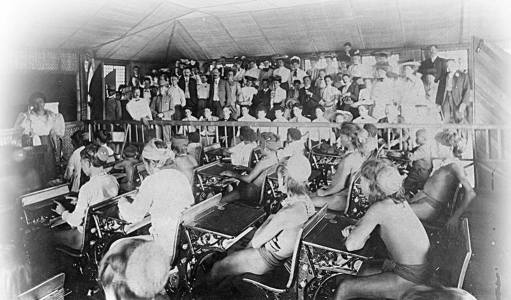
What aspect of imperialism does this photograph of a Filipina teacher and her students taken in the Philippine Reservation display at the 1904 St. Louis World's Fair convey to viewers?
A) The onlookers were concerned that these people have been put on display as subjects of imperialism.
B) Filipino students assimilated by adopting Western styles of dress.
C) Filipinos were well-educated and required little support from their American colonizers.
D) The primitiveness of the Filipino students was juxtaposed with the modern, assimilated teacher.

Unlock Deck
Unlock for access to all 49 flashcards in this deck.
Unlock Deck
k this deck
36
Why were members of the Anti-Imperialist League primarily concerned about acquisition of the Philippines?
A) They felt that the islands offered little strategic importance to the United States.
B) They disagreed with the concept of giving Filipinos the right to self-government.
C) They feared that a European power would try to colonize the Philippines and declare war.
D) They thought that undeveloped Asian countries would not be good markets for American industrialized goods.
A) They felt that the islands offered little strategic importance to the United States.
B) They disagreed with the concept of giving Filipinos the right to self-government.
C) They feared that a European power would try to colonize the Philippines and declare war.
D) They thought that undeveloped Asian countries would not be good markets for American industrialized goods.

Unlock Deck
Unlock for access to all 49 flashcards in this deck.
Unlock Deck
k this deck
37
Why did William Jennings Bryan ask anti-imperialist Democrats to support ratification of the Treaty of Paris after the Spanish-American War?
A) He wanted the United States to grant the Philippines independence.
B) He knew that annexing Cuba would improve the American economy.
C) He wanted American Christian values spread to the Philippines and Cuba.
D) He wanted Filipinos, Cubans, and Hawaiians to become American citizens.
A) He wanted the United States to grant the Philippines independence.
B) He knew that annexing Cuba would improve the American economy.
C) He wanted American Christian values spread to the Philippines and Cuba.
D) He wanted Filipinos, Cubans, and Hawaiians to become American citizens.

Unlock Deck
Unlock for access to all 49 flashcards in this deck.
Unlock Deck
k this deck
38
What was Theodore Roosevelt referring to when he told Congress that "no single great material work which remains to be undertaken on this continent is of such consequence to the American people"?
A) construction of the Panama Canal
B) discovering a vaccine for yellow fever and malaria
C) completion of a transcontinental railroad
D) passage of the Roosevelt Corollary to the Monroe Doctrine
A) construction of the Panama Canal
B) discovering a vaccine for yellow fever and malaria
C) completion of a transcontinental railroad
D) passage of the Roosevelt Corollary to the Monroe Doctrine

Unlock Deck
Unlock for access to all 49 flashcards in this deck.
Unlock Deck
k this deck
39
How did the United States and Japan compromise over the issue of Japanese immigration to this country?
A) Japan agreed to all restrictions on immigration to the United States in return for a greater colonial presence in China.
B) Japan accepted San Francisco's mandate to segregate all Asian students in one set of schools in exchange for more lenient immigration rights.
C) Both countries came to a Gentlemen's Agreement in which Japan conceded to deny passports to workers intending to immigrate to the United States.
D) Japan agreed to allow Russia access to Manchuria in return for allowing Japanese workers to immigrate to the United States.
A) Japan agreed to all restrictions on immigration to the United States in return for a greater colonial presence in China.
B) Japan accepted San Francisco's mandate to segregate all Asian students in one set of schools in exchange for more lenient immigration rights.
C) Both countries came to a Gentlemen's Agreement in which Japan conceded to deny passports to workers intending to immigrate to the United States.
D) Japan agreed to allow Russia access to Manchuria in return for allowing Japanese workers to immigrate to the United States.

Unlock Deck
Unlock for access to all 49 flashcards in this deck.
Unlock Deck
k this deck
40
The Filipino practice of guerrillas posing as friendly peasants during the day, then fighting against American troops at night was known as .
A) "an unholy war of conquest"
B) the "water cure"
C) "amigo warfare"
D) reconcentration
A) "an unholy war of conquest"
B) the "water cure"
C) "amigo warfare"
D) reconcentration

Unlock Deck
Unlock for access to all 49 flashcards in this deck.
Unlock Deck
k this deck
41
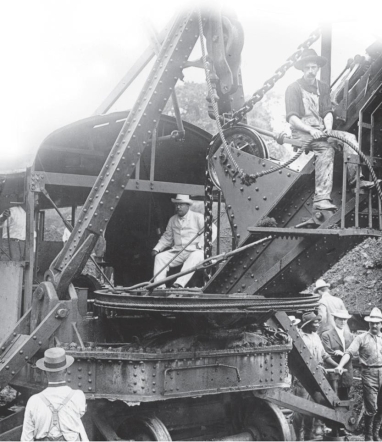
How does this photograph of President Theodore Roosevelt working the controls of a steam shovel in the Panama Canal Zone exemplify the spirit of imperialism that took hold in the United States during the late nineteenth and early twentieth centuries?
A) It is reflective of the democratic process that the United States used to acquire the Canal Zone from Colombia.
B) It shows how technological innovation promoted overseas economic expansion and world prominence for the United States.
C) It demonstrates the lack of sensitivity shown to native laborers who were considered to be racially and culturally inferior.
D) It addresses the method used by Americans to "civilize" non-American lands and people.

Unlock Deck
Unlock for access to all 49 flashcards in this deck.
Unlock Deck
k this deck
42
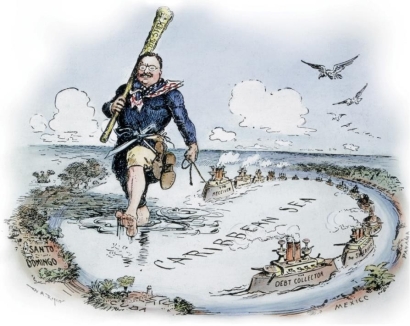
How does this cartoon illustrate the Roosevelt Corollary to the Monroe Doctrine?
A) Roosevelt is shown to be about the same size as the Caribbean nations, representing the equality between these nations and the United States.
B) The nations that border the Caribbean Sea loom large in Roosevelt's field of vision, creating a sense of difficulty in managing such unstable countries.
C) A large Roosevelt dominates the Caribbean Sea to show that the United States can keep nearby nations in line and prevent the creation of European colonies here.
D) Roosevelt is barefoot and looks exhausted, representing the difficulties of maintaining U.S. dominance over European interests in the region.

Unlock Deck
Unlock for access to all 49 flashcards in this deck.
Unlock Deck
k this deck
43
What was the purpose of the 1904 Roosevelt Corollary to the Monroe Doctrine?
A) It declared that the United States would act as an international police power in Latin America so that Europeans would not intervene.
B) It was an important step in making the United States more isolated from the rest of the world.
C) It announced that the United States would play an economic role in China.
D) It specifically set up an economic plan where the United States would establish American banks in Latin America.
A) It declared that the United States would act as an international police power in Latin America so that Europeans would not intervene.
B) It was an important step in making the United States more isolated from the rest of the world.
C) It announced that the United States would play an economic role in China.
D) It specifically set up an economic plan where the United States would establish American banks in Latin America.

Unlock Deck
Unlock for access to all 49 flashcards in this deck.
Unlock Deck
k this deck
44
Why did Theodore Roosevelt worry that there could be a European invasion of the Caribbean during his presidency?
A) Since colonies in Asia and Africa were hard to maintain, European nations were seeking new territories.
B) France and Germany were anxious to establish control over the Panama Canal.
C) European nations had a strong interest in establishing markets for their goods in the Caribbean.
D) Countries like the Dominican Republic and Venezuela were indebted to European nations.
A) Since colonies in Asia and Africa were hard to maintain, European nations were seeking new territories.
B) France and Germany were anxious to establish control over the Panama Canal.
C) European nations had a strong interest in establishing markets for their goods in the Caribbean.
D) Countries like the Dominican Republic and Venezuela were indebted to European nations.

Unlock Deck
Unlock for access to all 49 flashcards in this deck.
Unlock Deck
k this deck
45
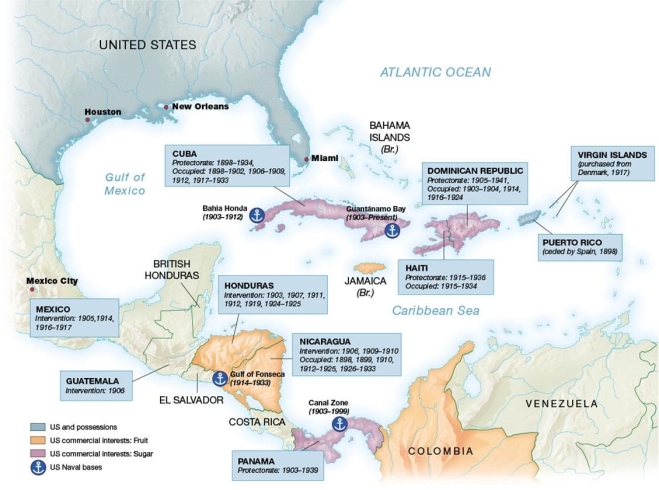
What does this map reveal about American interventions in the affairs of its southern neighbors in the forty-year period after the Spanish-American War?
A) U.S. military interventions were necessary in order to prevent European imperial powers from colonizing Latin American nations.
B) Most U.S. military incursions took place in areas where American economic interests were at risk.
C) Each area that experienced a U.S. military intervention was also an American protectorate.
D) The United States Navy played an insignificant role in keeping order in Latin America.

Unlock Deck
Unlock for access to all 49 flashcards in this deck.
Unlock Deck
k this deck
46
Why did President Roosevelt refer to Colombia's rulers as "contemptible little creatures"?
A) Roosevelt was unhappy that they were rebelling against Spain when the U.S. was already overextended.
B) Roosevelt thought that Colombians were primitive because they were not yet Christian.
C) Roosevelt was angry that they refused his offer of $10 million for American control of the Panama Canal.
D) Roosevelt wanted Colombia to rebel against Panama so that Panama would have no choice but to open the canal to the United States.
A) Roosevelt was unhappy that they were rebelling against Spain when the U.S. was already overextended.
B) Roosevelt thought that Colombians were primitive because they were not yet Christian.
C) Roosevelt was angry that they refused his offer of $10 million for American control of the Panama Canal.
D) Roosevelt wanted Colombia to rebel against Panama so that Panama would have no choice but to open the canal to the United States.

Unlock Deck
Unlock for access to all 49 flashcards in this deck.
Unlock Deck
k this deck
47
Why did the federal government under President Taft institute the Dollar Diplomacy policy?
A) to gain access to the Panama Canal in Central America
B) to establish economic ties in China and other Asian nations
C) to pay for the expenses associated with the construction of the Panama Canal
D) to maintain U.S. economic dominance in Latin America
A) to gain access to the Panama Canal in Central America
B) to establish economic ties in China and other Asian nations
C) to pay for the expenses associated with the construction of the Panama Canal
D) to maintain U.S. economic dominance in Latin America

Unlock Deck
Unlock for access to all 49 flashcards in this deck.
Unlock Deck
k this deck
48
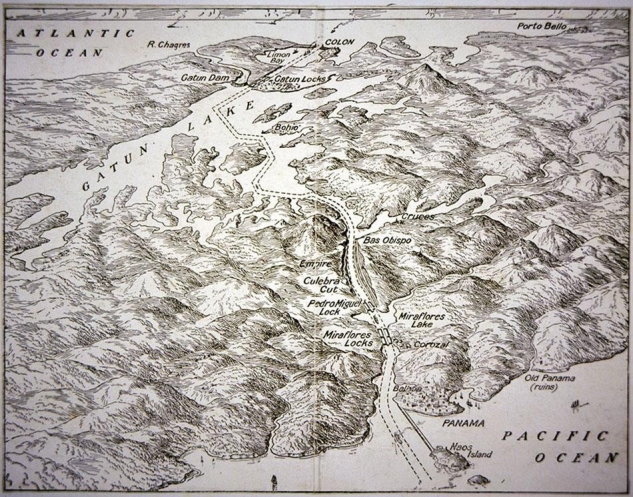
How does this map reveal American engineers' technological ability to control the natural elements that made construction of the Panama Canal so challenging?
A) The surrounding tropical jungle was removed to avoid any type of obstructions on the canal.
B) Construction was rerouted so that the waterway flowed through a natural lake.
C) A series of locks and dams was created to construct the waterway in an area prone to flooding.
D) Dynamite was used to blast through mountain ranges that prevented the canal from flowing across the Isthmus of Panama.

Unlock Deck
Unlock for access to all 49 flashcards in this deck.
Unlock Deck
k this deck
49
After buying the project from the Panama Canal Company, how did the United States gain control of the region where the Panama Canal was built?
A) The U.S. Congress sent Colombia $25 million to grant Panama its independence.
B) American troops attacked Colombia to gain access to the canal for the United States.
C) Colombia decided to grant Panama its independence in exchange for favorable trading status.
D) U.S. naval forces supported the Panamanian revolt against Colombia.
A) The U.S. Congress sent Colombia $25 million to grant Panama its independence.
B) American troops attacked Colombia to gain access to the canal for the United States.
C) Colombia decided to grant Panama its independence in exchange for favorable trading status.
D) U.S. naval forces supported the Panamanian revolt against Colombia.

Unlock Deck
Unlock for access to all 49 flashcards in this deck.
Unlock Deck
k this deck



